
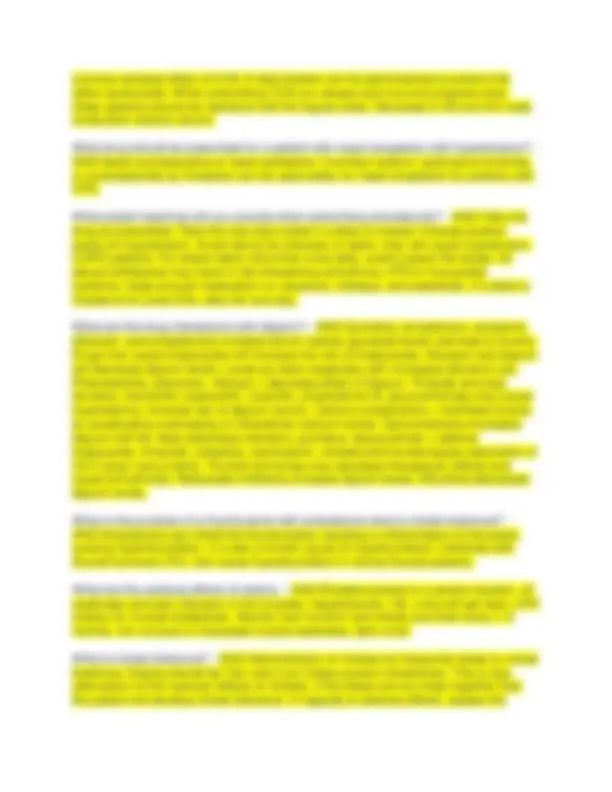
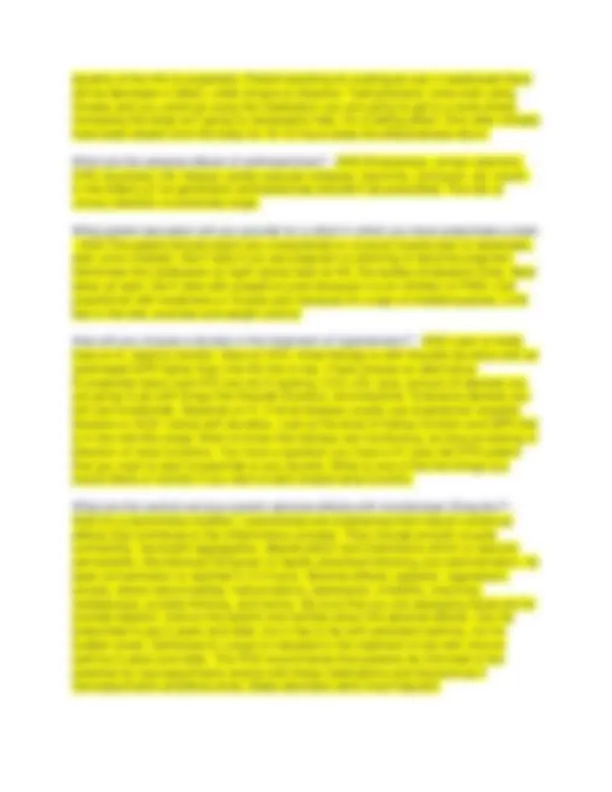
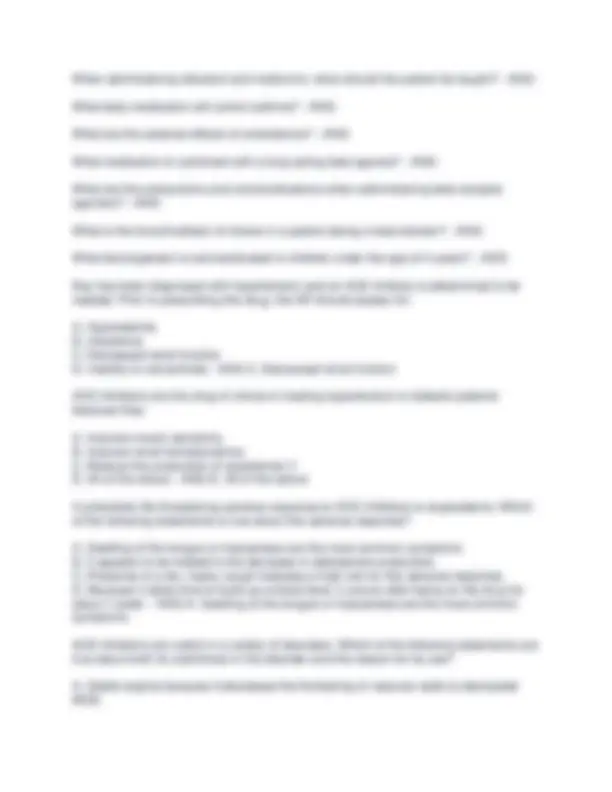
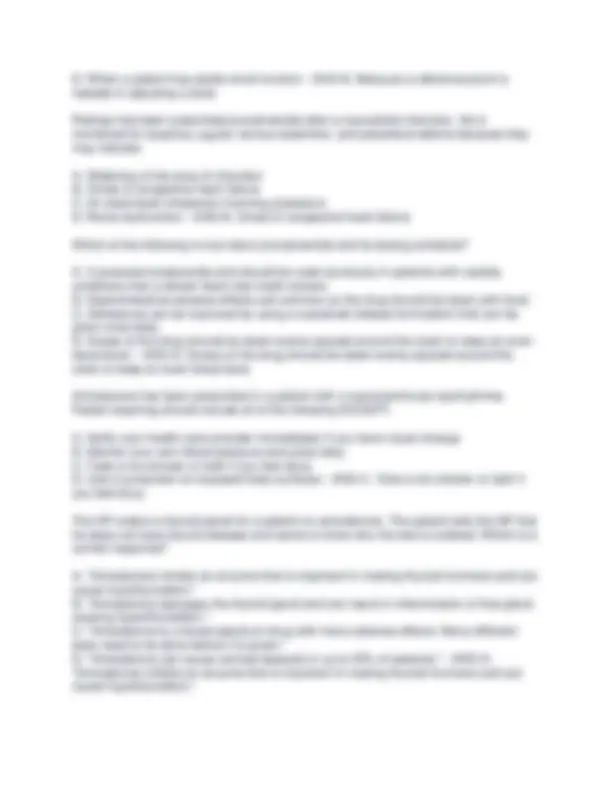
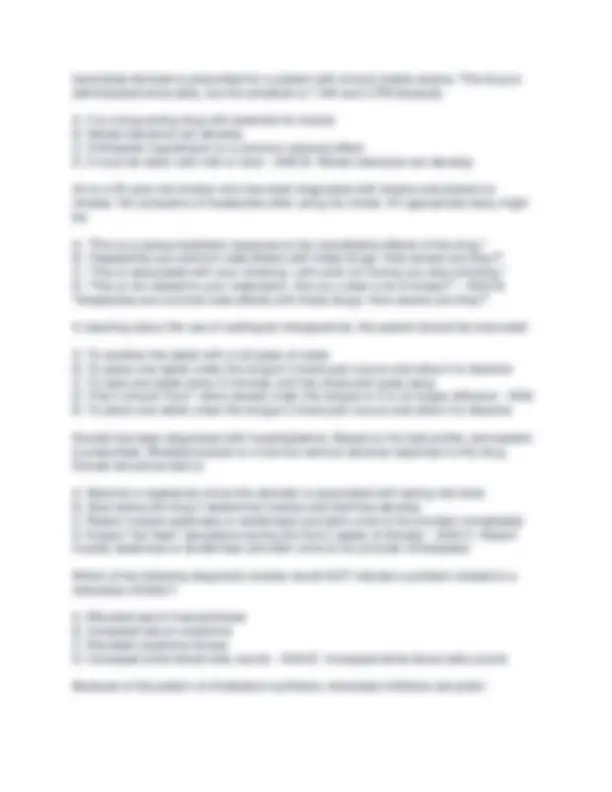
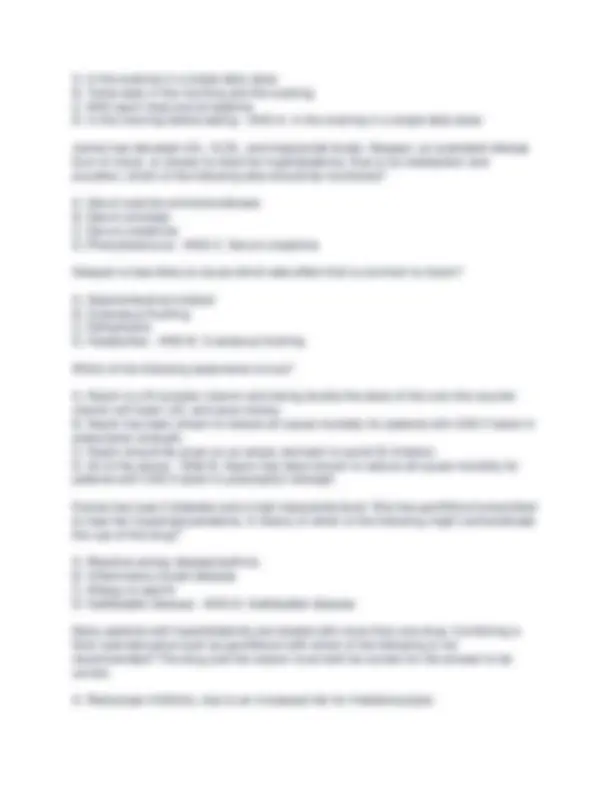
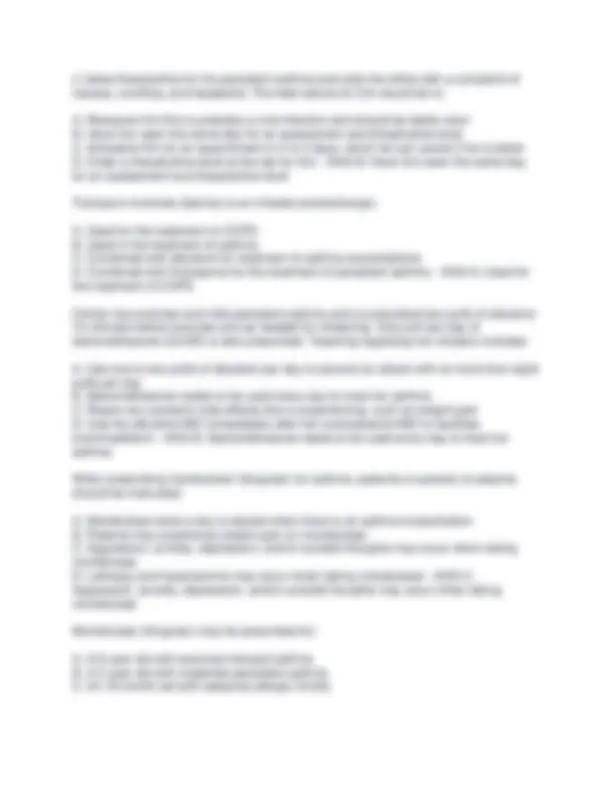
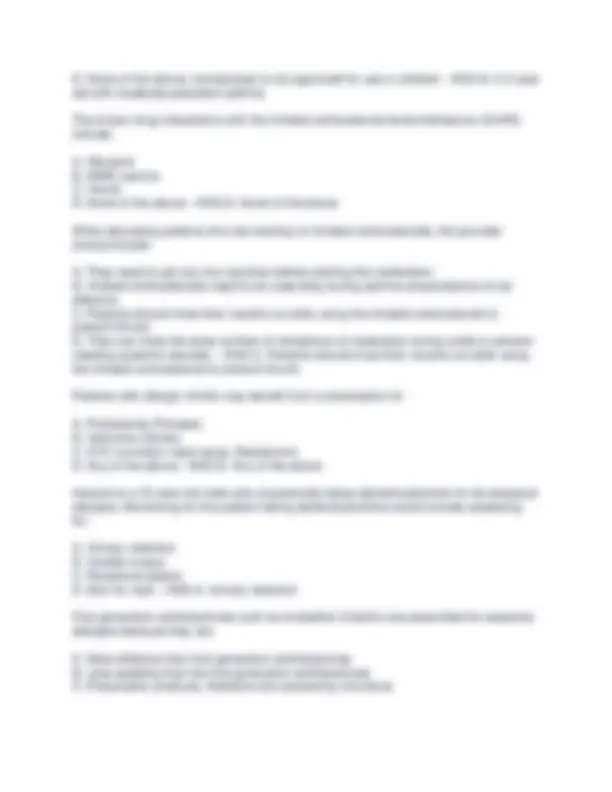

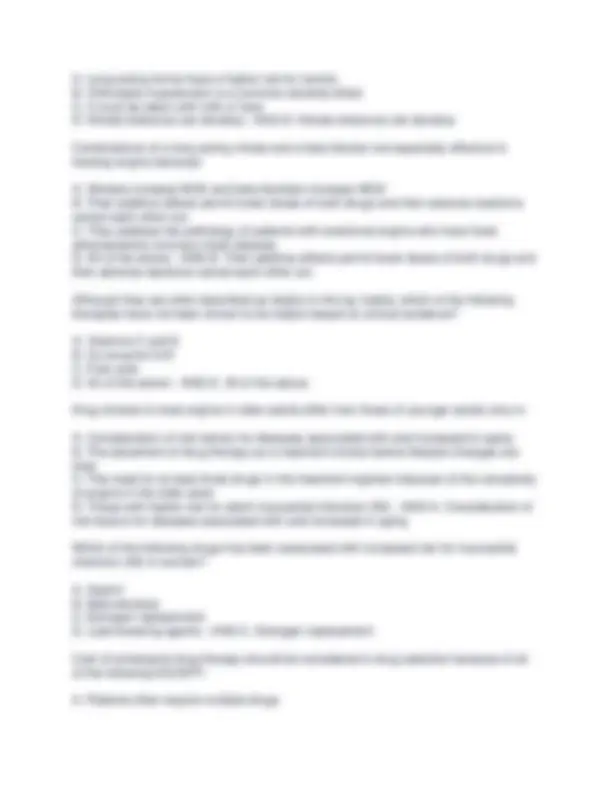
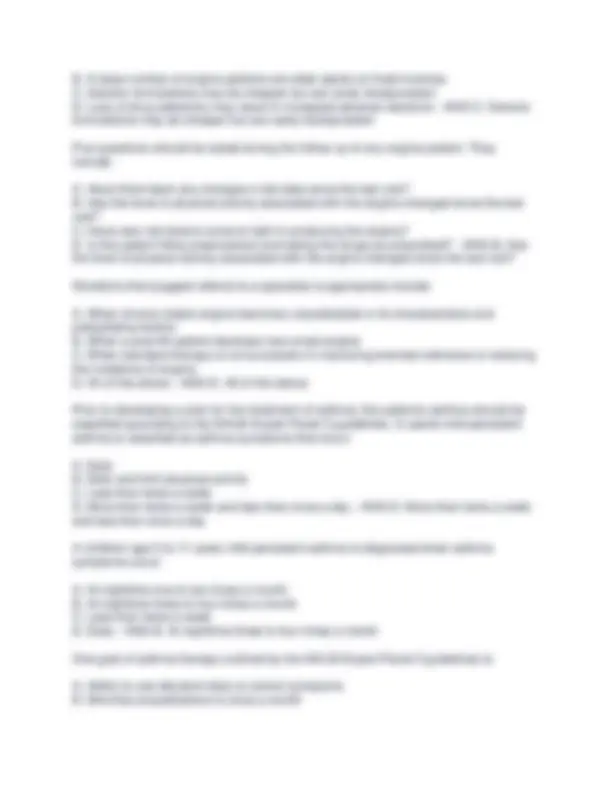
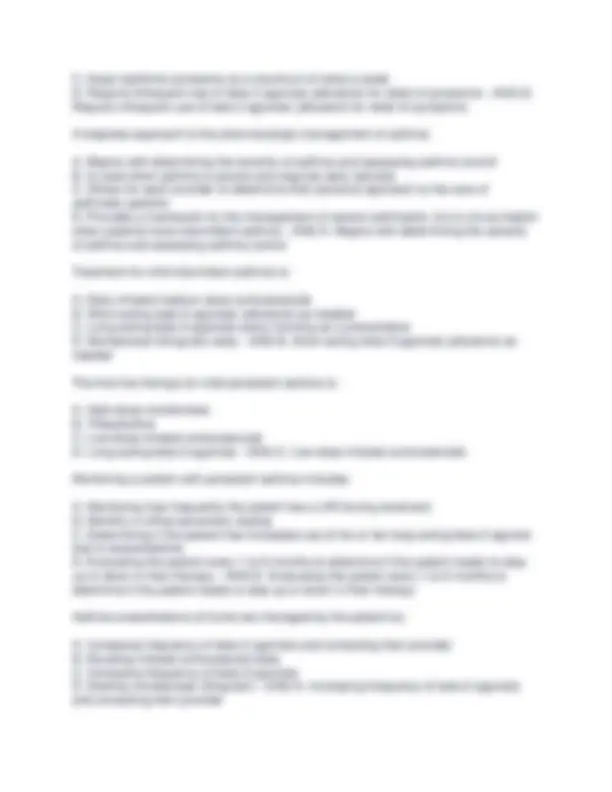
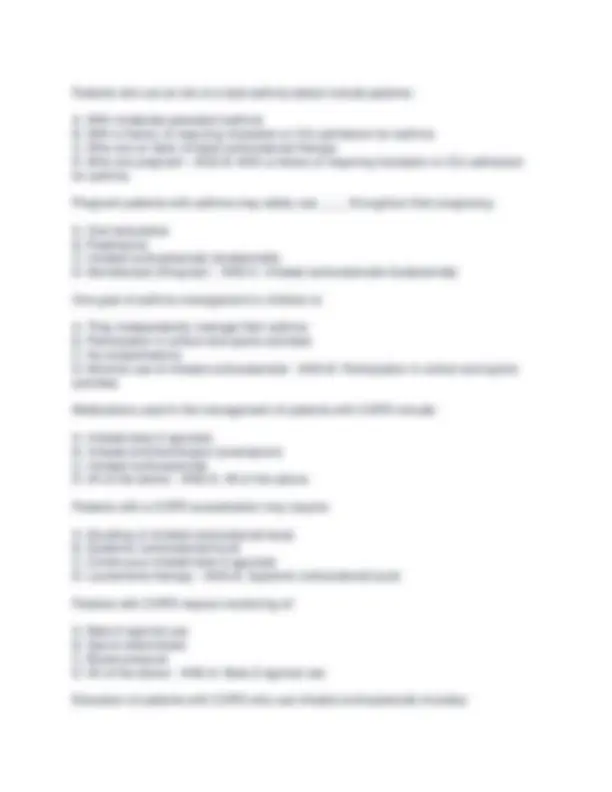
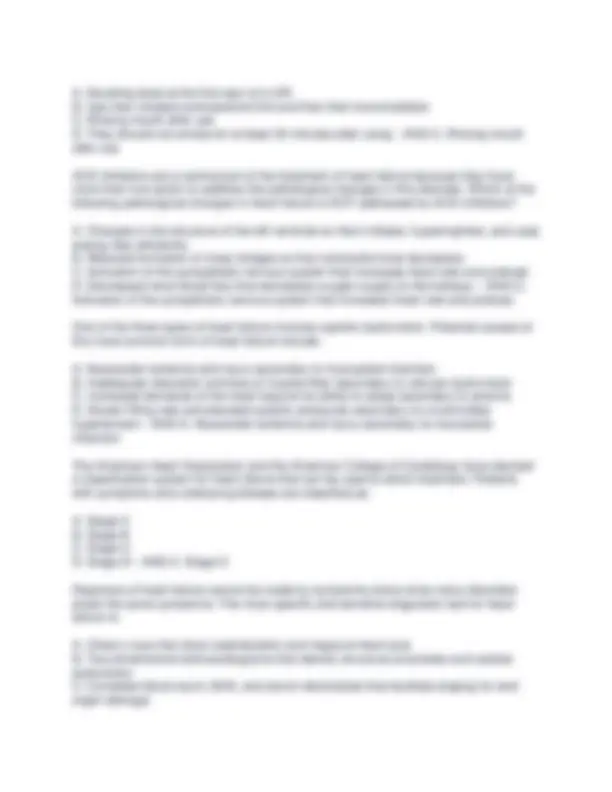
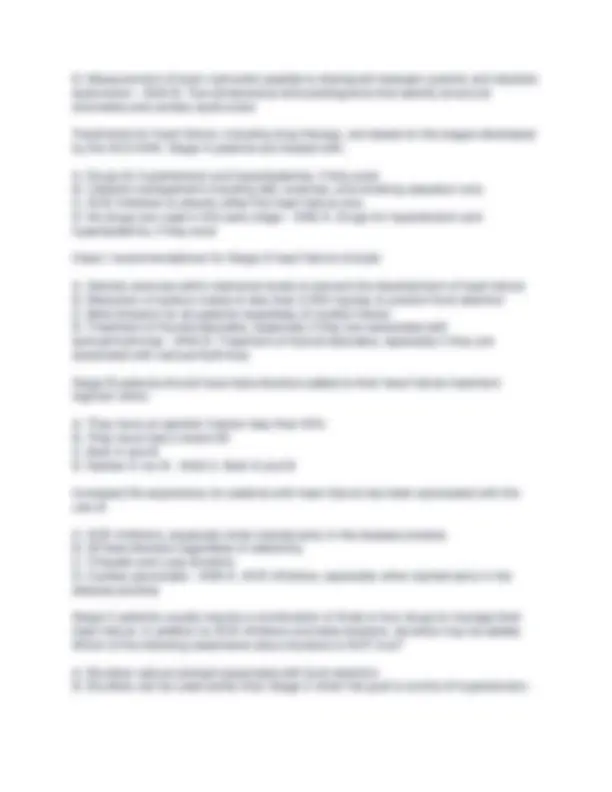
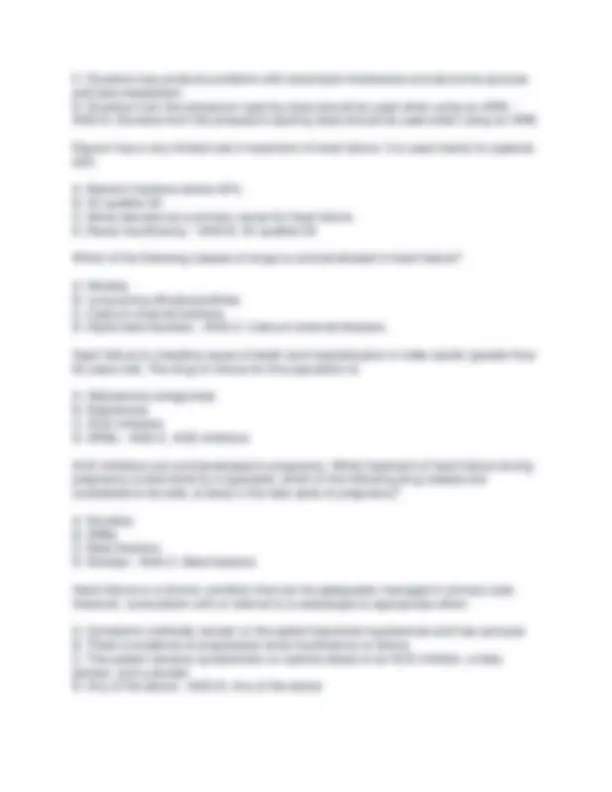


Study with the several resources on Docsity

Earn points by helping other students or get them with a premium plan


Prepare for your exams
Study with the several resources on Docsity

Earn points to download
Earn points by helping other students or get them with a premium plan
Community
Ask the community for help and clear up your study doubts
Discover the best universities in your country according to Docsity users
Free resources
Download our free guides on studying techniques, anxiety management strategies, and thesis advice from Docsity tutors
Detailed information on the pharmacological management of various cardiovascular and respiratory conditions, including hypertension, angina, asthma, and copd. It covers topics such as the mechanism of action, adverse effects, and monitoring requirements for different drug classes used in the treatment of these conditions. The document also discusses the importance of patient education and the stepwise approach to asthma management. Overall, this comprehensive resource would be valuable for healthcare professionals, particularly those involved in the care of patients with cardiovascular and respiratory disorders.
Typology: Exams
1 / 24

This page cannot be seen from the preview
Don't miss anything!

















What assessments should be made before prescribing any antihypertensive agent? - ANS-BP, RF, and head to toe assessment. Assess diet, sodium intake, electrolytes, and potassium levels. Prior to prescribing any antihypertensives, creatinine and BUN levels should be evaluated. Confirmation of elevated BP at 3 different times. Children over 3 years old should be assessed at least once at every visit-preferred method for children is by auscultation, the correct measurement requires using a cuff that is appropriate to the child's upper arm. 12 lead EKG. UA, albumin, albumin/creatinine ratio. Diabetics or those with renal disease should have the albumin/creatinine ratio annually. The presence of albuminuria, micro albuminuria even in the setting of normal GFR is associated with increased cardiovascular risk. Blood sugar, hct, serum calcium, and lipid profile. Why are ACE inhibitors the drug of choice in diabetic patients with hypertension? - ANS-ACE-Is will improve insulin sensitivity, as well as reduce the effects of DM on the kidneys. Protect the kidneys, watch for renal function, any creatinine >2.5 requires dose reduction. Prevents diabetic nephropathy or slow its progression. Reduce albuminuria and BP. ACEIs and ARBs should be used to treat the HTN. Renal protection, reduces the conversion of AT II and improve the insulin sensitivity. What is the drug of choice to improve symptoms for patients taking propranolol? - ANS- Ipratropium What is the most common adverse effect of an ACE inhibitor? - ANS-Dry, hacking cough in some patients. Can switch to an angiotensin blocker which won't cause cough. Reduce dose with either of these if Cr >2.5. Most are associated with hypotension, dizziness, HA, fatigue, orthostatic hypotension, tachyphylaxis. What is the action of an ACE inhibitor? - ANS-Decreases angiotensin II and aldosterone. Vasodilatation on the venous and arterial sides of the heart. Blocks the RAAS system leads to rennin acts on angiotensinogen to angiotensin I to angiotensin II through ACE. Angiotensin II stimulates aldosterone causing sodium and water while losing potassium via the kidney. ACE is also involved in the inactivation of bradykinin a vasodilator. Bradykin is what causes the cough (irritating the lungs). What is the action of an Angiotensin Receptor Blocker? - ANS-Blocks the angiotensin II receptor to leading to increasing vascular tone and stimulating vascular smooth muscle contraction. One of the greatest advantages: doesn't produce the dry, hacking cough that ACE-Is do. Similar to ACE-I except to bradykinin activity (no cough), lowers BP, decreases vascular resistance, decreases pulmonary cap wedge pressure, decreases HR, increases cardiac index.
What ethnic background should not be prescribed long-acting beta-agonists? - ANS- African Americans, increased incidence of death in this population What is tiotropium used to treat? - ANS-COPD, after patient stops smoking, this medication slow the progression of COPD. What is the action of a Calcium Channel Blocker? - ANS-Decrease the amount of calcium inside the cell to control blood pressure. Dihydropyridine CCB: inhibits transmembrane influx of extracellular calcium ions across myocardial and vascular smooth muscle cell membranes without changing serum calcium concentrations. This results in inhibition of cardiac and vascular smooth muscle contraction, thereby dilating main coronary and systemic arteries. Vasodilatation with decreased peripheral resistance and increased heart rate. Nondihydropyridine CCB: inhibits extracellular calcium ion influx across membranes of myocardial cells and vascular smooth muscle cells. Resulting in inhibition of cardiac and vascular smooth muscle contraction and thereby dilating main coronary and systemic arteries. No effect on serum calcium contractions. Substantial inhibitory effects on cardiac conduction system, acting principally at AV node, with some effects at sinus node. What are the adverse effects of a dihydropyridine-type calcium channel blocker? - ANS- Causes edema of the feet and hands, especially feet. Amlodipine and nifedipine. Type 2 (dihydropyridine=vessel loving) = peripheral edema. Type 1 (non-dihydropyridine=heart loving)=bradycardia, dizziness, hypotension. A 70-year-old patient is admitted with peripheral edema. He is taking a calcium channel blocker and metformin. What is the cause of his peripheral edema? - ANS-The edema is not related to metformin. Type 1 CCB more commonly exhibit peripheral edema. Pts report swelling of the hands, feet, ankles, and decreased urine output. What special populations should not be prescribed pseudoephedrine? - ANS-Children under the age of 4, first line treatment for coughs and colds is increased fluids and symptomatic management. Schedule III- addictive personalities, HTN, CAD. Children under 4= Infants cause sudden death, not recommended for children under 4. Anytime thinking of cough and cold medications you should always think of the elderly, very young and HTN. How is amlodipine metabolized? - ANS-All CCBs are metabolized by the liver in the CYP 3A4. Avoid, don't administer CCB with grapefruit juice, it will increase amlodipine level. Has a half life of 30-50 hours (56hr in hepatic impairment), eliminated via urine. A patient is prescribed amlodipine. She develops reflex tachycardia. What is the reason for the development of bradycardia? - ANS-It increases the myocardial oxygen delivery in patients with angina. Sub-peripheral vasodilatation causes such a dramatic drop in BP that baroreceptor reflex is triggered. The baroreceptors are in the aortic arch. The baroreceptor causes sympathetic stimulation of the heart. It increases pulse, it increases contractile force. Peripheral or facial edema can result. Hypotension is a
severity of the HA (is expected). Patient teaching for sublingual use: if swallowed there will be decrease in effect, under tongue to dissolve. Tachyphylaxis: once start using nitrates and you continue using the medication you are going to get to a level where increasing the dose isn't going to necessarily help. It's a ceiling effect. Only after nitrates have been absent from the body for 10-12 hours does the effectiveness return. What are the adverse effects of antihistamines? - ANS-Drowsiness, urinary retention, HTN, dizziness, HA, fatigue, cardio vascular collapse, insomnia, confusion, dry mouth. In the elderly pt 1st generation antihistamines shouldn't be prescribed. The risk of urinary retention is extremely large. What patient education will you provide for a client in which you have prescribed a statin
When administering albuterol and metformin, what should the patient be taught? - ANS- What daily medication will control asthma? - ANS- What are the adverse effects of amiodarone? - ANS- What medication is combined with a long acting beta agonist? - ANS- What are the precautions and contraindications when administering beta receptor agonists? - ANS- What is the bronchodilator of choice in a patient taking a beta blocker? - ANS- What decongestant is contraindicated in children under the age of 4 years? - ANS- Ray has been diagnosed with hypertension and an ACE inhibitor is determined to be needed. Prior to prescribing this drug, the NP should assess for: A. Hypokalemia B. Impotence C. Decreased renal function D. Inability to concentrate - ANS-C. Decreased renal function ACE inhibitors are the drug of choice in treating hypertension in diabetic patients because they: A. Improve insulin sensitivity B. Improve renal hemodynamics C. Reduce the production of angiotensin II D. All of the above - ANS-D. All of the above A potentially life-threatening adverse response to ACE inhibitors is angioedema. Which of the following statements is true about this adverse response? A. Swelling of the tongue or hoarseness are the most common symptoms. B. It appears to be related to the decrease in aldosterone production. C. Presence of a dry, hacky cough indicates a high risk for this adverse response. D. Because it takes time to build up a blood level, it occurs after being on the drug for about 1 week. - ANS-A. Swelling of the tongue or hoarseness are the most common symptoms. ACE inhibitors are useful in a variety of disorders. Which of the following statements are true about both its usefulness in the disorder and the reason for its use? A. Stable angina because it decreases the thickening of vascular walls to decreased MOD.
A. Increase calcium intake to prevent osteoporosis from calcium blockade. B. Do not crush the tablet; it must be given in liquid form if the patient has trouble swallowing it. C. Avoid grapefruit juice as it affects the metabolism of this drug. D. Rise slowly from a supine position to reduce orthostatic hypotension. - ANS-C. Avoid grapefruit juice as it affects the metabolism of this drug. Vera, age 70, has isolated systolic hypertension. Calcium channel blocker doses for her should be: A. Started at about half the usual dose B. Not raised above the usual dose for an adult C. Given once daily due to memory issues in the older adult D. Withheld if she experiences gastroesophageal reflux - ANS-A. Started at about half the usual dose Larry has heart failure which is being treated with digoxin because it exhibits: A. Negative inotropism B. Positive chronotropism C. Both A and B D. Neither A nor B - ANS-D. Neither A nor B Furosemide is added to a treatment regimen for heart failure which includes digoxin. Monitoring for this combination includes: A. Hemoglobin B. Serum potassium C. Blood urea nitrogen D. Serum glucose - ANS-B. Serum potassium Which of the following create higher risk for digoxin toxicity? Both the cause and the reason for it must be correct. A. Older adults due to reduced renal function B. Administration of aldosterone antagonist diuretics due to decreased potassium levels C. Taking an antacid for GERD because it increases the absorption of digoxin D. Doses between 0.25 and 0.5 mg/day - ANS-A. Older adults due to reduced renal function Serum digoxin levels are monitored for potential toxicity. Monitoring should occur: A. Within 6 hours of the last dose B. Because a reference point is needed in adjusting a dose C. After three half-lives from the starting of the drug
D. When a patient has stable renal function - ANS-B. Because a reference point is needed in adjusting a dose Rodrigo has been prescribed procainamide after a myocardial infarction. He is monitored for dyspnea, jugular venous distention, and peripheral edema because they may indicate: A. Widening of the area of infarction B. Onset of congestive heart failure C. An electrolyte imbalance involving potassium D. Renal dysfunction - ANS-B. Onset of congestive heart failure Which of the following is true about procainamide and its dosing schedule? A. It produces bradycardia and should be used cautiously in patients with cardiac conditions that a slower heart rate might worsen. B. Gastrointestinal adverse effects are common so the drug should be taken with food. C. Adherence can be improved by using a sustained release formulation that can be given once daily. D. Doses of this drug should be taken evenly spaced around the clock to keep an even blood level. - ANS-D. Doses of this drug should be taken evenly spaced around the clock to keep an even blood level. Amiodarone has been prescribed in a patient with a supraventricular dysrhythmia. Patient teaching should include all of the following EXCEPT: A. Notify your health-care provider immediately if you have visual change B. Monitor your own blood pressure and pulse daily C. Take a hot shower or bath if you feel dizzy D. Use a sunscreen on exposed body surfaces - ANS-C. Take a hot shower or bath if you feel dizzy The NP orders a thyroid panel for a patient on amiodarone. The patient tells the NP that he does not have thyroid disease and wants to know why the test is ordered. Which is a correct response? A. "Amiodarone inhibits an enzyme that is important in making thyroid hormone and can cause hypothyroidism." B. "Amiodarone damages the thyroid gland and can result in inflammation of that gland causing hyperthyroidism." C. "Amiodarone is a broad spectrum drug with many adverse effects. Many different tests need to be done before it is given." D. "Amiodarone can cause corneal deposits in up to 25% of patients." - ANS-A. "Amiodarone inhibits an enzyme that is important in making thyroid hormone and can cause hypothyroidism."
A. In the evening in a single daily dose B. Twice daily in the morning and the evening C. With each meal and at bedtime D. In the morning before eating - ANS-A. In the evening in a single daily dose Janice has elevated LDL, VLDL, and triglyceride levels. Niaspan, an extended-release form of niacin, is chosen to treat her hyperlipidemia. Due to its metabolism and excretion, which of the following labs should be monitored? A. Serum alanine aminotransferase B. Serum amylase C. Serum creatinine D. Phenylketonuria - ANS-C. Serum creatinine Niaspan is less likely to cause which side effect that is common to niacin? A. Gastrointestinal irritation B. Cutaneous flushing C. Dehydration D. Headaches - ANS-B. Cutaneous flushing Which of the following statements is true? A. Niacin is a B-complex vitamin and taking double the dose of the over-the-counter vitamin will lower LDL and save money. B. Niacin has been shown to reduce all-cause mortality for patients with CAD if taken in prescription strength. C. Niacin should be given on an empty stomach to avoid GI irritation. D. All of the above - ANS-B. Niacin has been shown to reduce all-cause mortality for patients with CAD if taken in prescription strength. Dulcea has type 2 diabetes and a high triglyceride level. She has gemfibrozil prescribed to treat her hypertriglyceridemia. A history of which of the following might contraindicate the use of this drug? A. Reactive airway disease/asthma B. Inflammatory bowel disease C. Allergy to aspirin D. Gallbladder disease - ANS-D. Gallbladder disease Many patients with hyperlipidemia are treated with more than one drug. Combining a fibric acid derivative such as gemfibrozil with which of the following is not recommended? The drug and the reason must both be correct for the answer to be correct. A. Reductase inhibitors, due to an increased risk for rhabdomyolysis
B. Bile-acid sequestering resins, due to interference with folic acid absorption C. Grapefruit juice, due to interference with metabolism D. Niacin, due to decreased gemfibrozil activity - ANS-A. Reductase inhibitors, due to an increased risk for rhabdomyolysis Felicity has been prescribed colestipol to treat her hyperlipidemia. Unlike other anti- lipidemics, this drug: A. Blocks synthesis of cholesterol in the liver B. Exchanges chloride ions for negatively charged acids in the bowel C. Increases HDL levels the most among the classes D. Blocks the lipoprotein lipase pathway - ANS-B. Exchanges chloride ions for negatively charged acids in the bowel Because of their site of action, bile acid sequestering resins: A. Should be administered separated from other drugs by at least 4 hours B. May increase the risk for bleeding C. Both A and B D. Neither A nor B - ANS-A. Should be administered separated from other drugs by at least 4 hours Colestipol comes in a powdered form. The patient is taught to: A. Take the powder dry and follow it with at least 8 ounces of water B. Take it with a meal to enhance its action on fatty food C. Mix the powder with 4 to 6 ounces of milk or fruit juice D. Take after the evening meal to coincide with cholesterol synthesis - ANS-C. Mix the powder with 4 to 6 ounces of milk or fruit juice The choice of diuretic to use in treating hypertension is based on: A. Presence of diabetes with loop diuretics being used for these patients B. Level of kidney function with a thiazide diuretic being used for an estimated glomerular filtration rate higher than the mid-40 mL/min range C. Ethnicity with aldosterone antagonists best for African Americans and older adults D. Presence of hyperlipidemia with higher doses needed for patients with LDL above 130 mg/dL - ANS-B. Level of kidney function with a thiazide diuretic being used for an estimated glomerular filtration rate higher than the mid-40 mL/min range Digoxin levels need to be monitored closely when the following medication is started: A. Loratadine B. Diphenhydramine C. Ipratropium D. Albuterol - ANS-D. Albuterol
Li takes theophylline for his persistent asthma and calls the office with a complaint of nausea, vomiting, and headache. The best advice for him would be to: A. Reassure him this is probably a viral infection and should be better soon B. Have him seen the same day for an assessment and theophylline level C. Schedule him for an appointment in 2 to 3 days, which he can cancel if he is better D. Order a theophylline level at the lab for him - ANS-B. Have him seen the same day for an assessment and theophylline level Tiotropium bromide (Spiriva) is an inhaled anticholinergic: A. Used for the treatment of COPD B. Used in the treatment of asthma C. Combined with albuterol for treatment of asthma exacerbations D. Combined with fluticasone for the treatment of persistent asthma - ANS-A. Used for the treatment of COPD Christy has exercise and mild persistent asthma and is prescribed two puffs of albuterol 15 minutes before exercise and as needed for wheezing. One puff per day of beclomethasone (QVAR) is also prescribed. Teaching regarding her inhalers includes: A. Use one to two puffs of albuterol per day to prevent an attack with no more than eight puffs per day B. Beclomethasone needs to be used every day to treat her asthma C. Report any systemic side effects she is experiencing, such as weight gain D. Use the albuterol MDI immediately after her corticosteroid MDI to facilitate bronchodilation - ANS-B. Beclomethasone needs to be used every day to treat her asthma When prescribing montelukast (Singulair) for asthma, patients or parents of patients should be instructed: A. Montelukast twice a day is started when there is an asthma exacerbation B. Patients may experience weight gain on montelukast C. Aggression, anxiety, depression, and/or suicidal thoughts may occur when taking montelukast D. Lethargy and hypersomnia may occur when taking montelukast - ANS-C. Aggression, anxiety, depression, and/or suicidal thoughts may occur when taking montelukast Montelukast (Singulair) may be prescribed for: A. A 6 year old with exercise-induced asthma B. A 2 year old with moderate persistent asthma C. An 18 month old with seasonal allergic rhinitis
D. None of the above; montelukast is not approved for use in children - ANS-B. A 2 year old with moderate persistent asthma The known drug interactions with the inhaled corticosteroid beclomethasone (QVAR) include: A. Albuterol B. MMR vaccine C. Insulin D. None of the above - ANS-D. None of the above When educating patients who are starting on inhaled corticosteroids, the provider should include: A. They need to get any live vaccines before starting the medication. B. Inhaled corticosteroids need to be used daily during asthma exacerbations to be effective. C. Patients should rinse their mouths out after using the inhaled corticosteroid to prevent thrush. D. They can triple the dose number of inhalations of medication during colds to prevent needing systemic steroids. - ANS-C. Patients should rinse their mouths out after using the inhaled corticosteroid to prevent thrush. Patients with allergic rhinitis may benefit from a prescription of: A. Fluticasone (Flonase) B. Cetirizine (Zyrtec) C. OTC cromolyn nasal spray (Nasalcrom) D. Any of the above - ANS-D. Any of the above Howard is a 72-year-old male who occasionally takes diphenhydramine for his seasonal allergies. Monitoring for this patient taking diphenhydramine would include assessing for: A. Urinary retention B. Cardiac output C. Peripheral edema D. Skin for rash - ANS-A. Urinary retention First generation antihistamines such as loratadine (Claritin) are prescribed for seasonal allergies because they are: A. More effective than first generation antihistamines B. Less sedating than the first generation antihistamines C. Prescription products, therefore are covered by insurance
Angina is produced by an imbalance between oxygen supply (MOS) and demand (MOD) in the myocardium. Which of the following drugs help to correct this imbalance by increasing MOS? A. Calcium channel blockers B. Beta blockers C. ACE inhibitors D. Aspirin - ANS-C. ACE inhibitors Not all chest pain is caused by myocardial ischemia. Non-cardiac causes of chest pain include: A. Pulmonary embolism B. Pneumonia C. Gastroesophageal reflux D. All of the above - ANS-D. All of the above The New York Heart Association and the Canadian Cardiovascular Society have described grading criteria for levels of angina. Angina that occurs with unusually strenuous activity or on walking or climbing stair after meals is: A. Class I B. Class II C. Class III D. Class IV - ANS-B. Class II Patients at high risk for developing significant coronary heart disease are those with: A. LDL values between 100 and 130 B. Systolic blood pressure between 120 and 130 C. Class III angina D. Obesity - ANS-C. Class III angina To reduce mortality, all patients with angina, regardless of Class, should be on: A. Aspirin 81 to 325 mg/d B. Nitroglycerin sublingually for chest pain C. ACE inhibitors or ARBs D. Digoxin - ANS-A. Aspirin 81 to 325 mg/d Patients who have angina, regardless of Class, who are also diabetic, should be on: A. Nitrates B. Beta blockers C. ACE inhibitors D. Calcium channel blockers - ANS-C. ACE inhibitors
Management of all types and grades of angina includes the use of lifestyle modification to reduce risk factors. Which of these modifications are appropriate for which reason? Both the modification and the reason for it must be true for the answer to be correct. A. Lose at least 10 pounds of body weight. Excessive weight increases cardiac workload. B. Reduce sodium intake to no more than 2,400 mg of sodium. Sodium increases blood volume and cardiac workload. C. Increase potassium intake to at least 100 mEq/d. The heart needs higher levels of potassium to improve contractility and oxygen supply. D. Intake a moderate amount of alcohol. Moderate intake has been shown by research to improve cardiac function. - ANS-B. Reduce sodium intake to no more than 2,400 mg of sodium. Sodium increases blood volume and cardiac workload. Nitrates are especially helpful for patients with angina who also have: A. Heart failure B. Hypertension C. Both A and B D. Neither A nor B - ANS-C. Both A and B Beta blockers are especially helpful for patients with exertional angina who also have: A. Arrhythmias B. Hypothyroidism C. Hyperlipidemia D. Atherosclerosis - ANS-A. Arrhythmias Rapid-acting nitrates are important for all angina patients. Which of the following are true statements about their use? A. These drugs are useful for immediate symptom relief when the patient is certain it is angina. B. The dose is one sublingual tablet or spray every 5 minutes until the chest pain goes away. C. Take one nitroglycerine tablet or spray at the first sign of angina; repeat every 5 minutes for no more than three doses. If chest pain is still not relieved, go to the hospital. D. All of the above - ANS-C. Take one nitroglycerine tablet or spray at the first sign of angina; repeat every 5 minutes for no more than three doses. If chest pain is still not relieved, go to the hospital. Isosorbide dinitrate is a long-acting nitrate given BID. The schedule for administration is 7 AM and 2 PM because:
B. A large number of angina patients are older adults on fixed incomes C. Generic formulations may be cheaper but are rarely bioequivalent D. Lack of drug selectivity may result in increased adverse reactions - ANS-C. Generic formulations may be cheaper but are rarely bioequivalent Five questions should be asked during the follow up of any angina patient. They include: A. Have there been any changes in lab data since the last visit? B. Has the level of physical activity associated with the angina changed since the last visit? C. Have new risk factors come to light in producing the angina? D. Is the patient filling prescriptions and taking the drugs as prescribed? - ANS-B. Has the level of physical activity associated with the angina changed since the last visit? Situations that suggest referral to a specialist is appropriate include: A. When chronic stable angina becomes unpredictable in its characteristics and precipitating factors B. When a post-MI patient develops new-onset angina C. When standard therapy is not successful in improving exercise tolerance or reducing the incidence of angina D. All of the above - ANS-D. All of the above Prior to developing a plan for the treatment of asthma, the patient's asthma should be classified according to the NHLBI Expert Panel 3 guidelines. In adults mild-persistent asthma is classified as asthma symptoms that occur: A. Daily B. Daily and limit physical activity C. Less than twice a week D. More than twice a week and less than once a day - ANS-D. More than twice a week and less than once a day In children age 5 to 11 years mild-persistent asthma is diagnosed when asthma symptoms occur: A. At nighttime one to two times a month B. At nighttime three to four times a month C. Less than twice a week D. Daily - ANS-B. At nighttime three to four times a month One goal of asthma therapy outlined by the NHLBI Expert Panel 3 guidelines is: A. Ability to use albuterol daily to control symptoms B. Minimize exacerbations to once a month
C. Keep nighttime symptoms at a maximum of twice a week D. Require infrequent use of beta 2 agonists (albuterol) for relief of symptoms - ANS-D. Require infrequent use of beta 2 agonists (albuterol) for relief of symptoms A stepwise approach to the pharmacologic management of asthma: A. Begins with determining the severity of asthma and assessing asthma control B. Is used when asthma is severe and requires daily steroids C. Allows for each provider to determine their personal approach to the care of asthmatic patients D. Provides a framework for the management of severe asthmatics, but is not as helpful when patients have intermittent asthma - ANS-A. Begins with determining the severity of asthma and assessing asthma control Treatment for mild intermittent asthma is: A. Daily inhaled medium dose corticosteroids B. Short-acting beta- 2 - agonists (albuterol) as needed C. Long-acting beta- 2 - agonists every morning as a preventative D. Montelukast (Singulair) daily - ANS-B. Short-acting beta- 2 - agonists (albuterol) as needed The first-line therapy for mild-persistent asthma is: A. High-dose montelukast B. Theophylline C. Low-dose inhaled corticosteroids D. Long-acting beta- 2 - agonists - ANS-C. Low-dose inhaled corticosteroids Monitoring a patient with persistent asthma includes: A. Monitoring how frequently the patient has a URI during treatment B. Monthly in-office spirometry testing C. Determining if the patient has increased use of his or her long-acting beta- 2 - agonist due to exacerbations D. Evaluating the patient every 1 to 6 months to determine if the patient needs to step up or down in their therapy - ANS-D. Evaluating the patient every 1 to 6 months to determine if the patient needs to step up or down in their therapy Asthma exacerbations at home are managed by the patient by: A. Increasing frequency of beta- 2 - agonists and contacting their provider B. Doubling inhaled corticosteroid dose C. Increasing frequency of beta- 2 - agonists D. Starting montelukast (Singulair) - ANS-A. Increasing frequency of beta- 2 - agonists and contacting their provider